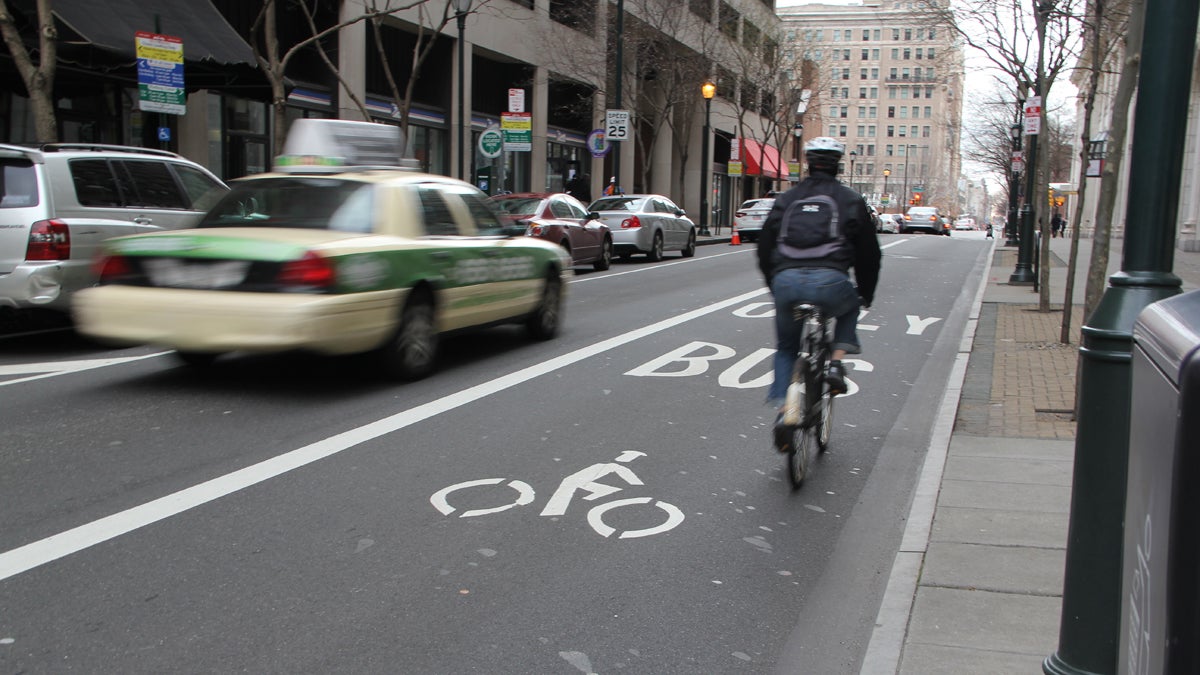Philly bike lanes up 13 percent under Nutter

The bus and bike only lane on Chestnut Avenue is widely ignored. (Emma Lee/for NewsWorks)
The city of Philadelphia has added about 50 miles of bike lanes during Mayor Michael Nutter’s tenure to date, bringing the city’s network to nearly 435 miles.
The city of Philadelphia has added about 50 miles of bike lanes during Mayor Michael Nutter’s tenure to date, bringing the city’s network to nearly 435 miles.
Though the number of new lanes is low, representing about a 13 percent increase, city officials say they connect previously disjointed bikeways to create a more comprehensive network.
“In 2008, one of the things we were working on was saying, ‘How can we extend this grid, connect things together and provide access into Center City, where all the trips are anyway?’ So that was really our focus,” said Charles Carmalt, hired as the city’s first pedestrian and bicycle coordinator in 2008.
Prior to 2008, bike lanes were added where it was easy to carve out space for them, or where they made streets safer for cars, he said.
“That was not resulting in a real network or grid,” Carmalt said.
The lanes added since 2008 were harder to build, in the case of Spruce and Pine streets requiring planners to remove a lane of vehicle traffic.
“They were more difficult projects, but the projects resulted in a network that people could use,” Carmalt said.
The city also added almost 30 miles of “sharrows,” traditional car lanes marked with symbols aimed at reminding drivers to share the road, and indicating the lane safest for bikers.
“Mayor Nutter showed us, and the city, that there are many opportunities to make streets safer, and much more comfortable and attractive to bicyclists and to pedestrians, by making relatively modest improvements,” said Sarah Clark Stuart, deputy director of the Bicycle Coalition of Greater Philadelphia.
By expanding the city’s trail network, adding buffered bike lanes, and working toward a bike-share system scheduled to debut this spring, Stuart said Nutter broke new ground for bicycling in Philadelphia.
“Bicycling is now baked into the city’s culture and infrastructure, and the work that Mayor Nutter has done has really made that possible,” Stuart said. “(But) there’s still work to do.”
According to the Coalition’s December “Safer Streets” report, the city lagged behind New York, Boston, Chicago, Pittsburgh and Baltimore in building new bikeways during the first six years of Nutter’s term.
The city also lacks protected bicycle lanes, those separated from car traffic with posts or bollards.
“Those kinds of lanes are being installed in other cities and add a higher degree of safety,” Stuart said. “It’s very unfortunate that we don’t have one yet.”
These protected bike lanes, or “cycle tracks,” were called for in the city’s 2012 Pedestrian and Bicycle Plan.
WHYY is your source for fact-based, in-depth journalism and information. As a nonprofit organization, we rely on financial support from readers like you. Please give today.

